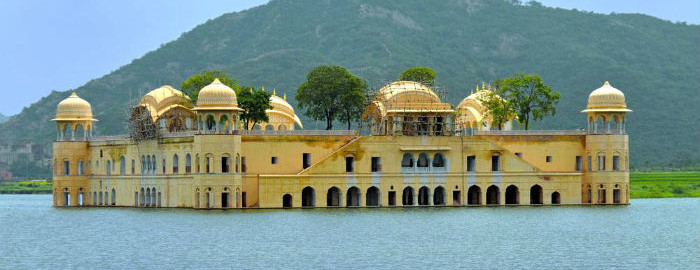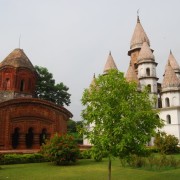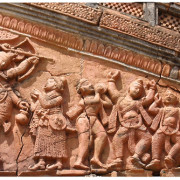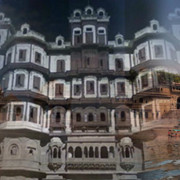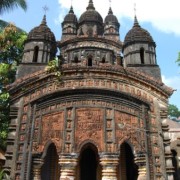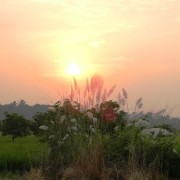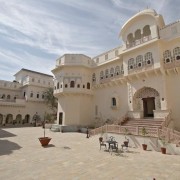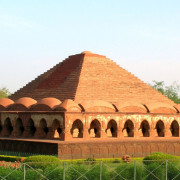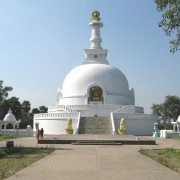Jaipur, Rajasthan – The pink city
Known as the pink city, Jaipur is the capital of Rajasthan. The city is named after its founder, the warrior and astronomer sovereign, Maharaja Sawai Jai Singh (ruled 1700 to 1743). Designed by Vidyadhar Bhattacharya some pink buildings and constructions are still found in the older Jaipur. The pink city can easily catch anyone’s admiration. Jaipur being a busy metropolis still holds an age old charm that really creating a sense of wonder upon the visitors. It is a major tourist destination in India.
Places to see in Jaipur: Jaipur has a number of tourist attractions that includes palaces, museum, fort and many other things. Being a city with rich architectural splendour, Jaipur is a historical wonderland.
Hawa Mahal
The poet king Sawai Pratap Singh built this palace of winds. This is the icon of Jaipur. It is located in the City Palace complex, and is best viewed from the road outside. This five-storey building that faces the busy bazaar street is a fascinating example of Rajput architecture and artistry with its delicately honeycombed 953 pink sandstone windows known as ‘jharokhas’. It was originally built for the ladies of the royal household to watch everyday life and processions in the city from their veiled comfort. Most people come here to get a view of the facade but they can also climb to the top for a wonderful view from the latticed windows. There is also a small archaeological museum there.
Amber Fort
Just 11 km from Jaipur is the Fort of Amber. It was the ancient citadel of the ruling Kachwahas of Amber, before the capital was shifted to the plains, the present day Jaipur. The architecture of the fort is the fascinating blend of Hindu and Mughal architecture. Constructed by Raja Man Singh I in 1592 and completed by Mirja Raja Jai Singh the fort was made in red sand stone and white marble. The fort consists of sprawling gardens, grand, chambers and large rooms. A rich decoration and excellent planning mark the construction of the Amber Palace.
City Palace
Situated at the core of the pink city, this magnificent palace complex with its numerous edifices, vast courtyards and attractive gardens is the prominent example of the royal history. Built by Maharaja Sawai Jai Singh its architecture is a blend of Mughal and Rajput architecture. The Chandra Mahal and Mubarak Mahal are some of the significant structures in the complex. To preserve the valuable items of the bygone era, many compartments of the palace have been converted into museums and art galleries. To witness the beauty of the palace, thousands of visitors from across the world visit the City Palace every year.
Nahargarh Fort
Nahargarh fort stands at the edge of the Aravalli hills. The word Nahargarh means “abode of tigers”. The Fort gives a mesmerizing view of the pink city of Jaipur. The fort has been part of important historical events: treaties of the Marathas were signed here, and it was the refuge of British women during the Sepoy Mutiny. The fort served as a hunting residence for the kings.
Jantar Mantar
Built by Maharaja Jai Singh, this observatory, officially declared as the national monument, has a huge collection of astronomical instruments. Beautifully crafted in marble and local stone, it is one of the largest buildings in the country that is dedicated to the exploration of celestial bodies. It consists of around 14 fixed and focused devices that measure time, predict eclipses, track stars, and locate earth orbits around the sun.
Jaigarh Fort
Most spectacular of the three-hilltop forts, Jaigarh fort overlooks Jaipur. In Mughal times, the Jaipur region was a major weapon-producing centre for the Mughal and Rajput rulers, several of the weapons being on display in the fort’s museum. It is one of the few military structures of medieval India preserved almost intact, containing palaces, a granary, a well-planned cannon foundry, several temples, a tall tower and giant mounted cannon-the Jai Ban (Jaivan) which is the largest cannon on wheels in the world. Jaigarh Fort is also known as the fort of victory. The display includes a collection of canons, many of which are exquisitely decorated and were used in the Mughal campaigns led by the Rajput King, Raja Man Singh.
Albert Hall
It is one of the oldest museums in Jaipur as well as in India, and was built by Sir Samuel Jacob in the 19th Century. It is known as the state’s museum for Rajasthan and is also well known as the Government Central Museum. The beautiful building is located in the Ram Niwas garden, and stands as the epitome of the conglomeration of the Indo Saracen architecture. Here one can find a rich collection of numerous artefacts like carpets, paintings, stones, ivory, sculptures made up of metal, crystal works decorated with colours and every item that depicts the royal culture of Rajasthan.
Moti Dungri and Ganesh Temple
In the middle of Jaipur is a small hill Moti Dungri meaning pearl hill, because it looks like a drop of pearl. An exotic palace is perched atop the hill which is a replica of a Scottish castle once occupied by Maharaja Sawai Man Singh. From there on, it remained a private property of the royal family. In the recent past it served as a home for Rajmata Gaytri Devi’s only son, the late Jagat Singh. The mere view of this castle is exotic enough. The highlight of this place is the famous and auspicious temple of Lord Ganesh, which is situated at the hill. It is frequented by Jaipurites on religious occasions.
Nearby attractions from Jaipur: From here you can visit the places like
Bagru
This place is just 35 kms away from Jaipur on the Ajmer road leading to Ajmer and is well known for hand block printing on cloth known as Bagru prints.
Tonk
Tonk is located 96 kms away from Jaipur. This is a quiet town which was ruled by ‘Pathans’ from Afghanistan. The focal point of Tonk is the Suneri Kothi, the Golden Bungalow. A fairly ordinary looking monument from outside, it has stunningly rich ornamental interiors. There are some interesting buildings that accommodated the British office. Tonk is also famous for its leather and felt industry and one can pick up a good bargain from the markets. The Nawab of Tonk was an avid book lover and built a sizable library of Arabic and Persian manuscripts. The Arabic and Persian Research Institute is also located here.
Sanganer
Sanganer is located 16 Kms from Jaipur. It is also known for exquisite Jain temples. Moreover, it is an important centre for crafts and hand-printed textiles that are internationally famous.
Karauli
Located at 182 km southwest of Jaipur, it was founded in 1348 and is best known for its famous temples Shri Madan Mohan Temple, Shri Mahaveer Temple, Shri Kaila Devi Temple, Shri Balaji Temple etc. The Bhanwar Vilas Palace, which is owned by the descendants of the royal family and resembles a large manor, is a heritage hotel now. The rooms and meals are available. Karauli is best connected by bus or taxi from Jaipur.
Virat Nagar
Situated on the Jaipur -Alwar state highway at a distance of about 75 Kms from Jaipur, Viratnagar is richly populated with unique and historical Venues which have largely escaped tourist attention. It is in the area of important and recognized tourist destinations such as Sariska (a Project Tiger sanctuary), Siliserh, Ajabgarh- Bhangarh and Alwar. The venues are not only of great historical importance but are also in a reasonably good state. They can be easily opened to the ever- increasing tourist traffic to the colorful state if Rajasthan. Being close to Jaipur, Alwar and Delhi they can also serve as a welcome break for the tourists already traveling on this circuit. A complex of rock shelter and natural cave shelters found in different hills of Viratnagar indicate the presence of prehistorical people from the beginning of early stone age up to late stone age. The city is said to have been founded by King Virat in whose kingdom the five pandavas spent the thirteen-year of their exile in disguise (Agyatwas). The place Viratnagar assumed a special significance during the period of Mahabharata.
Things to do in Jaipur: Besides visiting these wonderful historical place, you can also be a part of the various fairs that is held in Jaipur every year like Elephant festival, Gangaur festival, Jaipur festival, Kite festival, Teej festival.
Best time to visit Jaipur: Jaipur has a warm climate but October to March can be described as the best time to visit the pink city.
How to go ?
By Air
The Jaipur Airport is situated at Sanganer, 7 km (domestic terminal) and 10 km (international terminal) from the main city. It connects the city to all the major parts of India as well as some of the major overseas countries. I
By Train
Jaipur is well connected to almost every part of India through the means of Indian Railways.
By Road
Jaipur, the pink city is linked with the all the major cities of India through the network of National Highways 8, 11 and 12 to name a few. There’s also a very good bus service between Jaipur and Delhi provided by Rajasthan State Road Transport Corporation (RSRTC) with the buses at about every half an hour to and from both sides.
Where to stay ?
There are plenty of lodging facility in Jaipur. Some options are:
Hotel Jaipur Palace: + 91-0141-2743161-64 Website: www.jaipurpalace.in
Hotel Umaid Mahal: +91-141-2201952, 2201954 Website: www.umaidmahal.com
Hotel Narain Niwas Palace: +91-141-256 1291, 256 3448 Website: www.hotelnarainniwas.com
Hotel Silver Plaza: +91- 0141- 228 3000 Website: www.hotelsilverplaza.in
Note: Phone numbers given above are according to the information available with us. If you find any contact number/s given above is/are incorrect or not in use, please let us know.
.
.

